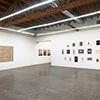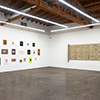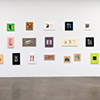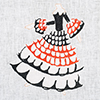Frock-Conscious Click on images to view project. |
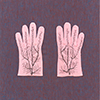 |
 |
|||||||
 |
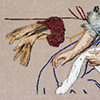 |
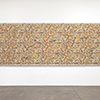 |
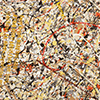 |
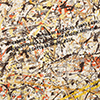 |
||||
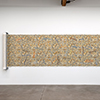 |
 |
 |
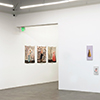 |
 |
||||
 |
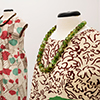 |
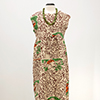 |
 |
 |
||||
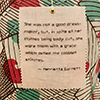 |
 |
 |
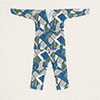 |
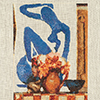 |
||||
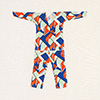 |
 |
 |
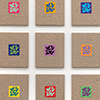 |
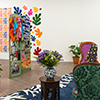 |
||||
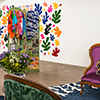 |
 |
 |
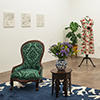 |
 |
||||
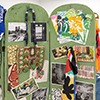 |
 |
 |
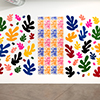 |
|||||
Frock-Conscious Shoshana Wayne Gallery, Los Angeles Frock-Conscious explores the relationship between textiles and painting through nearly fifty works produced over the past five years. Although the exhibition is primarily grounded in Reichek’s signature medium of embroidery, it also expands spatially to restage the studio itself as a blended site of artistic production, domestic life, intergenerational conversation, and critical investigation. In the large gallery is a salon-style installation of twenty-four embroideries, featuring images of clothing or textiles that Reichek has appropriated from a wide assortment of paintings, drawings, and designs. Collectively these art-historical sources read like an associative mini-survey of the artistic pleasures and challenges in rendering costume, drapery, and pattern — from Michelangelo, Bronzino, Gentileschi, and Watteau; to Delacroix, Tissot, Rousseau, and Vuillard; to Picasso, Miro, Stepanova, Delaunay-Terk, Thiebaud, Currin, and Marshall. Whether a full-bodied form or a tight crop, each image has been re-created entirely in thread, by either digital or hand-sewing techniques. Reichek thus engineers a cyclical translation of depicted fabric back into actual material, as well as a conceptual inversion of the distinctions between the fine arts and craft. Reichek’s investigation of the semiotic repertoire of fabric also examines its function as a second skin. On the salon-style wall, Oppenheim’s Gloves (Pink) links conceptually, across the gallery, to the haptic textures of Anna of Austria’s Gloves, and to theerotics of touch conjured by In Memorium (Marsden Hartley) and Mended Sock (Barbara Pym). As these last two works indicate, text and coding are additional through-lines: In contrast to Pym’s sock-mending drama, three small samplers compare darning patterns to the systems-work seriality of Sol LeWitt. Another hand embroidery, Turkey-Work (Susan Howe), quotes the poet’s terse, fragmentary meditation on a particular sewing application (which Reichek demoes in the work itself) whose meanings and associations have been displaced by larger historical forces. The two largest works in the exhibition, JP Textile/Text 1 and 2, reimagine Jackson Pollock’s legacy as a collision of metaphors and materials. Each work unfurls a considerable length (twelve and seventeen feet, respectively) of fabric commercially printed in two colorways with a pseudo-Pollock pattern — Spatter, by Kravet Inc. — over which Reichek has digitally sewn twenty-five citations selected from Pollock’s critical bibliography. Each citation is embroidered in a distinct typeface and appears randomly at least three times in each work, as Reichek cheekily literalizes the idioms “an embroidered reputation” and “art by the yard.” Reichek complements each colorway of Spatter with a bespoke palette of twenty-five-plus thread colors. JP Textile/Text 1 is presented on stretcher bars like a painting, while JP Textile/Text 2 is rolled out from a wall-mounted dispenser, like a custom readymade on demand. Rounding out this associative exploration of the repressed connections between Pollock and the decorative is a triptych of three silk charmeuse scarves that reproduce Cecil Beaton’s 1951 photoshoot, for Vogue, of models in couture gowns posing against Pollock’s drip paintings at Betty Parsons Gallery. The small gallery space stages a conversational installation devoted to Henri Matisse and the Bloomsbury artists Vanessa Bell, Duncan Grant, and Roger Fry. Although Matisse profoundly influenced the Bloomsbury artists, their entrepreneurial efforts actually anticipated his own forays into commercial decoration and textiles by nearly two decades. Along the right as one enters, several works reflect on the Bloomsbury artists’ sustained engagement with fabrics and patterns, both in their paintings and through their short-lived but influential design business, Omega Workshops. Two digital embroideries present in distinct colorways a set of pajamas that Bell made for Fry in her fractured “Maud” pattern — with the larger work framed by an actual sample of this fabric, which is marketed today by The Charleston Trust. Another digital embroidery remakes the plaid dress depicted in Fry’s 1917 portrait of Nina Hamnett, in which “Maud” also reappears. And a final embroidery reconstitutes Grant’s 1971 painting Still Life with Matisse entirely in hand-sewn cross-stitches on linen. Reichek also displays two dresses made from Omega fabrics (also available from Charleston) that feature painterly patterning by Bell (“White”) and Grant (“West Wind”). Both are designed in a modern high-waisted, corset-free style, for which Bell herself was widely known within her social milieu. On the back of each is pinned a linen tag embroidered with a remembrance of Bell’s fashion sensibility from her daughter, Angelica, and her granddaughter Henrietta, respectively. (Reichek employed as dressmakers her own grandson Emmett and gallerist Shoshana Blank’s granddaughter Maya.) Folding screens are a stock motif in Matisse’s repertoire, and the double-sided green-velvet Screen Time with Matisse serves as a kind of Warburgian atlas of printed archival images, assorted fabric swatches, and miscellaneous merch. Here Reichek also examines the less attractive aspects of Matisse’s practice, including his primitivizing gaze and his ambiguous relationships with female models and assistants. And in a related mode of deconstruction, Scattered “Sheaf” with Felt and Fabric reimagines Matisse’s 1953 ceramic tile mural The Sheaf as fabric cut-outs pinned around a tricolor, imitation-block-print floral pattern. As Reichek brings each new round of conceptual and material repartee back to her own artistic production, she reveals herself as both subject and object, maker and viewer, fan and critic, engaged in an ever-renewing reflective dialogue.
|
